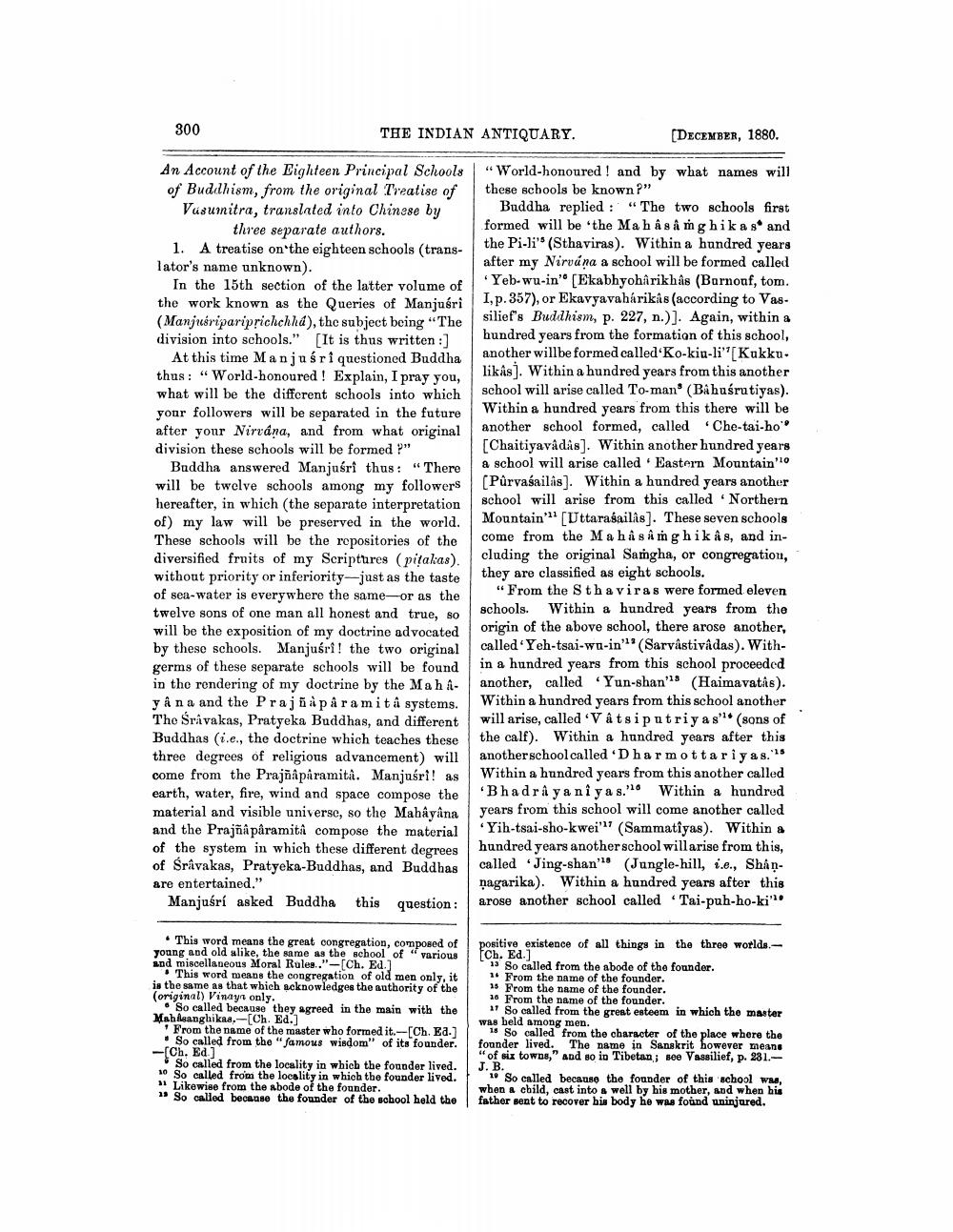________________
300
THE INDIAN ANTIQUARY.
An Account of the Eighteen Principal Schools of Buddhism, from the original Treatise of Vasumitra, translated into Chinese by three separate authors.
1. A treatise on the eighteen schools (translator's name unknown).
In the 15th section of the latter volume of
the work known as the Queries of Manjuśri (Manjusripariprichchha), the subject being "The division into schools." [It is thus written:]
At this time Manju śri questioned Buddha thus: "World-honoured! Explain, I pray you, what will be the different schools into which your followers will be separated in the future after your Nirvana, and from what original division these schools will be formed ?"
Buddha answered Manjuśri thus: "There will be twelve schools among my followers hereafter, in which (the separate interpretation of) my law will be preserved in the world. These schools will be the repositories of the diversified fruits of my Scriptures (pitakas). without priority or inferiority-just as the taste of sea-water is everywhere the same or as the twelve sons of one man all honest and true, so will be the exposition of my doctrine advocated by these schools. Manjuśri! the two original germs of these separate schools will be found in the rendering of my doctrine by the Mahâyâna and the Prajñàpâramit å systems. The Śravakas, Pratyeka Buddhas, and different Buddhas (i.e., the doctrine which teaches these three degrees of religious advancement) will come from the Prajñâpâramità. Manjuśri! as earth, water, fire, wind and space compose the material and visible universe, so the Mahayana and the Prajñâpâramitâ compose the material of the system in which these different degrees of Śrâvakas, Pratyeka-Buddhas, and Buddhas are entertained."
Manjuśrí asked Buddha this question:
This word means the great congregation, composed of young and old alike, the same as the school of and miscellaneous Moral Rules.."-[Ch. Ed.]
various
This word means the congregation of old men only, it is the same as that which acknowledges the authority of the (original) Vinayn only.
So called because they agreed in the main with the Mahisanghikas,-[Ch. Ed.]
From the name of the master who formed it.-[Ch. Ed.] So called from the "famous wisdom" of its founder. [Ch. Ed.]
So called from the locality in which the founder lived. 10 So called from the locality in which the founder lived. 11 Likewise from the abode of the founder.
1 So called because the founder of the school held the
[DECEMBER, 1880.
"World-honoured! and by what names will these schools be known?"
Buddha replied: "The two schools first formed will be the Mahâsâ mg hika s* and the Pi-li' (Sthaviras). Within a hundred years after my Nirvana a school will be formed called Yeb-wu-in' [Ekabhyohârikhâs (Barnouf, tom. I, p. 357), or Ekavyavahárikas (according to Vassilief's Buddhism, p. 227, n.)]. Again, within a hundred years from the formation of this school, another willbe formed called 'Ko-kiu-li" [Kukku. likâs]. Within a hundred years from this another school will arise called To-man (Bâhuśrutiyas). Within a hundred years from this there will be another school formed, called 'Che-tai-ho [Chaitiyavâdâs]. Within another hundred years a school will arise called Eastern Mountain"10 [Purvasailas]. Within a hundred years another school will arise from this called 'Northern Mountain" [Uttarasailis]. These seven schools come from the Mahasamghikâs, and including the original Samgha, or congregation, they are classified as eight schools.
"From the S tha viras were formed eleven schools. Within a hundred years from the origin of the above school, there arose another, called Yeh-tsai-wu-in" (Sarvâstivâdas). Within a hundred years from this school proceeded another, called 'Yun-shan's (Haimavatâs). Within a hundred years from this school another will arise, called 'Vâtsiputriyas" (sons of the calf). Within a hundred years after this another school called 'Dharmottariyas. 15 Within a hundred years from this another called 'Bhadrayaniyas. Within a hundred years from this school will come another called Yih-tsai-sho-kwei'" (Sammatîyas). Within a hundred years another school will arise from this, called Jing-shan's (Jungle-hill, i.e., Shannagarika). Within a hundred years after this arose another school called Tai-pub-ho-ki"
positive existence of all things in the three worlds.[Ch. Ed.]
13 So called from the abode of the founder.
1 From the name of the founder.
15 From the name of the founder.
16 From the name of the founder.
17 So called from the great esteem in which the master was held among men.
18 So called from the character of the place where the founder lived. The name in Sanskrit however means "of six towns," and so in Tibetan; see Vassilief, p. 231.
J. B.
19 So called because the founder of this school was, when a child, cast into a well by his mother, and when his father sent to recover his body he was found uninjured.




